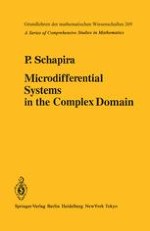1985 | OriginalPaper | Buchkapitel
ℰ X -modules
verfasst von : Pierre Schapira
Erschienen in: Microdifferential Systems in the Complex Domain
Verlag: Springer Berlin Heidelberg
Enthalten in: Professional Book Archive
Aktivieren Sie unsere intelligente Suche, um passende Fachinhalte oder Patente zu finden.
Wählen Sie Textabschnitte aus um mit Künstlicher Intelligenz passenden Patente zu finden. powered by
Markieren Sie Textabschnitte, um KI-gestützt weitere passende Inhalte zu finden. powered by
This chapter is devoted to the study of the algebraic structure of the sheaf of rings ℰX and of the usual operations on Modules over ℰX. The Ring ℰX has a Z-filtration induced by the order, and many properties of a ℤ-filtered Module M over a ℤ-filtered Ring A can be obtained from the corresponding ones on gr(M), the associated graded Module over gr(A), if we make the assumption that the filtration is what we call a “zariskian filtration”. We study the theory of filtered modules in the abstract in § 1, with special attention to characteristic ideals, flatness, homological dimension, coherency. The important theorem of O. Gabber [1] on the involutivity of the characteristic ideal is stated, but it seemed irrelevant to us to duplicate his very clear proof.Next we have to show that the filtration over ℰX is in fact a zariskian one. The proof follows that of Sato-Kashiwara-Kawaï [1] and is classical in its approach: induction on the dimension with the help of the division theorems. The main properties of ℰX then follow immediately: the sheaf ℰX is coherent and noetherian, and the characteristic cycle of a coherent ℰX-module is a conic analytic involutive cycle. As a corollary of the involutivity we get that the homological dimension of ℰX is equal to n the (complex) dimension of X, and even that any coherent Module locally admits a free resolution of length at most n.It is beyond the scope of this book to make a detailed study of holonomic Modules (i.e.: coherent Modules whose characteristic variety is Lagrangean). We just give the first properties of the category of holonomic Modules, and study the “adjoint” functor on this category.We end § 2 by introducing the “dummy variable” trick which enables to work outside of the zero section of T*X, and by finally studying the relations between coherent DX-modules and globally defined coherent ℰX-modules.Next we explain how one manipulates coherent gℰX-modules with the same ease as is possible for functions: tensor products for two Modules over two different manifolds, inverse images for left ℰX-modules (analogous to restriction for functions), direct images of right Modules (in line with integration of differential forms). All these constructions have been done in Sato-Kashiwara-Kawaï [1] using a deep cohomological method, but we proceed here in an elementary way, beginning with the study of these operations for Modules like IX|X, then passing to the general case. Non-characteristic restrictions of ℰX-modules are studied in detail, and we calculate exactly, following M. Kashiwara [5], the characteristic cycle of the induced system in this case.On the other hand direct images for proper maps are not studied here, and reference is made to Kashiwara [3] and Pham [1] for further developments on this subject (cf. also Chapter III, § 4).Finally we give a general formulation of the Cauchy problem for general systems, as preparation for the next chapter.
